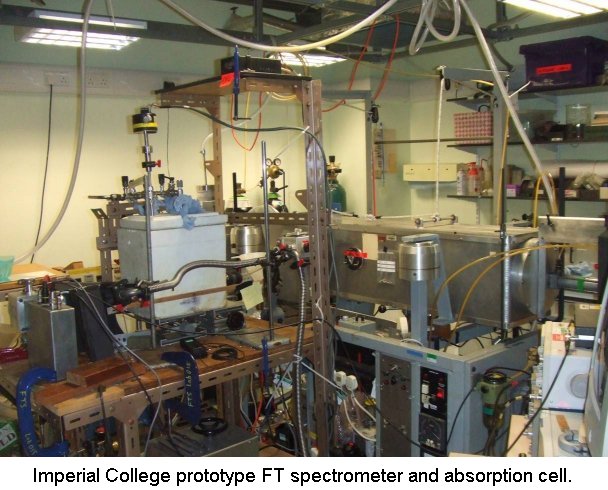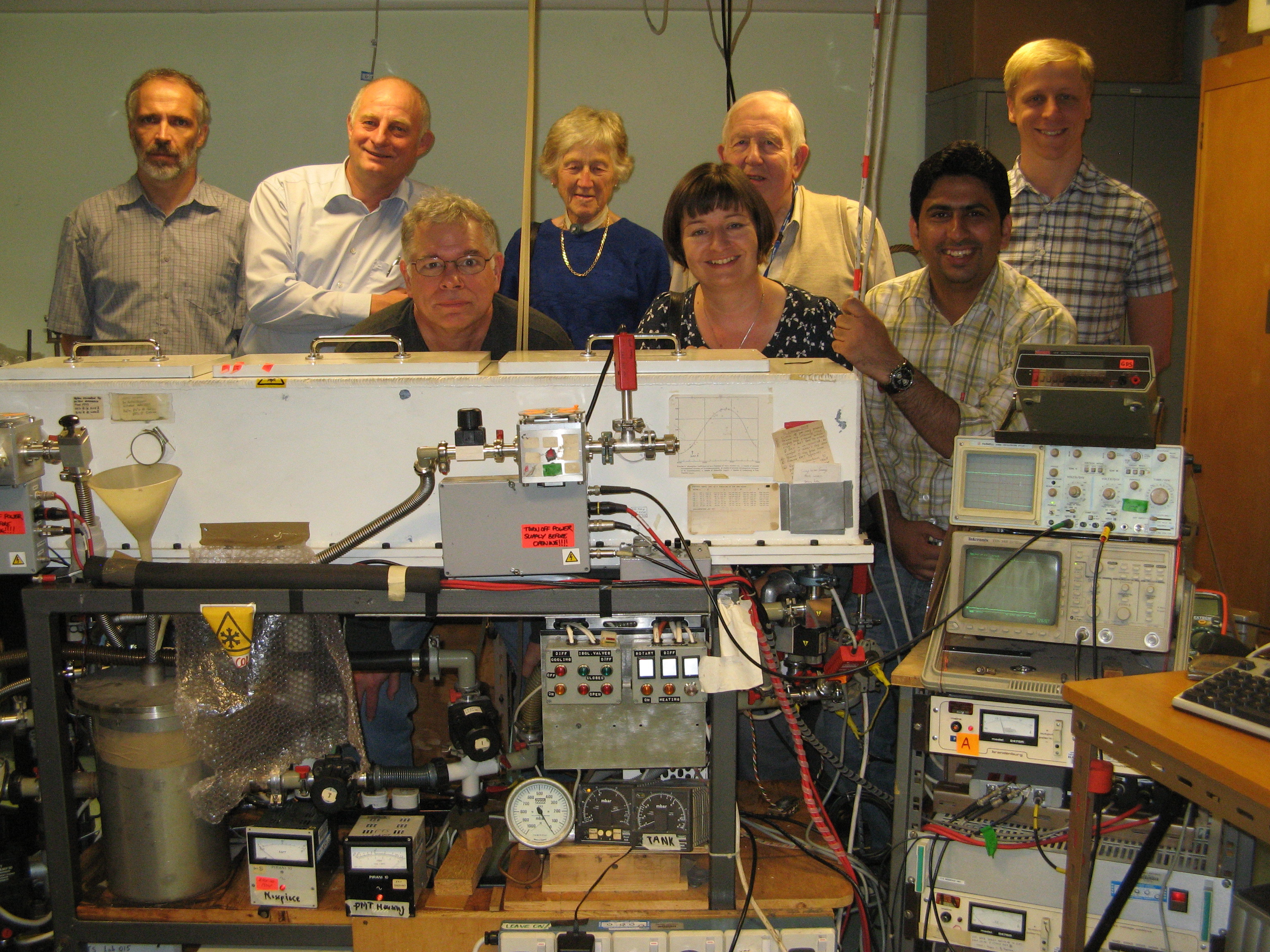Instrumentation
The FTS group has two FT spectrometers, similar in design but slightly different in a few respects.
Both are scanning Michelson interferometers, with catseye retroreflectors in place of plane mirrors.
The moving catseye has a travel of 10 cm either side of zero path difference, giving a resolution limit of 0.025 cm -1 - i.e., a
resolving power of 2 million at 200 nm. The double-sided interferogram is important for optimising phase correction in emission spectra.
The focal ratio is f/20 (25 mm diameter beam, 500 mm focal length). The angle of incidence on the beamsplitter is 5 degrees,
and the whole interferometer is enclosed in a vacuum tank only 1.5 m x 30 cm x 30 cm. Particular attention was paid to the
key components of the beamsplitter and the guidance system and drive for the moving catseye. In both instruments the guidance
system is a vee-block with large (14 mm) balls. In the older instrument (IC FTS) the beamsplitter consists of a silica disc with accurate
plane-parallel faces, one of which acts as beamsplitter and the other as beam recombiner. Slightly wedged silica pieces are
optically contacted to the non-reflecting sides of the disc to decohere back-surface reflections and reduce shear effects.
The drive is hydraulic, with a wobble pin connecting the oil-driven piston to the moving catseye. In the newer instrument (IC VUV FTS)
the beamsplitter is made in the same way, but the material is magnesium fluoride instead of silica so that the spectrometer
can be used (in principle) down to 120 nm. The drive in the newer instrument is a linear motor.
A stabilised He-Ne laser beam follows the same path as the signal beam through the interferometer
in order to monitor the path difference.
Owing to the catseye retroreflectors, the complementary interferogram returning in the direction of the source is offset
from the input beam and is steered to a second detector. The two beams can be added, to halve the effective integration time,
or they can be used independently - e.g., with two different detectors. In absorption spectroscopy we have placed the absorption
cell in front of one detector and used the other to monitor the continuum background simultaneously, thus establishing a baseline
independent of drifts in the intensity of the background source.
The design and performance of the UV FT spectrometer were described in a paper soon after its implementation in the mid-1980s.
Progress into the VUV region with the magnesium fluoride beamsplitter and various improvements to the other optical components are
summarised in a 1996 paper, A P Thorne, Fourier Transform Spectrometry in the Vacuum Ultraviolet: Applications and Progress.
Physica Scripta T65, 31-35 (1996). (Download Paper)
The greater part of our work with these two instruments has been done on emission spectra,
using demountable high current water-cooled hollow cathode lamps
with either argon, neon or helium as the carrier gas.
The cathodes usually have an internal diameter of 8 mm, and the lamps can be run at currents up to 1 amp from stabilised high
voltage power supplies. We also use a Penning light source with higher currents to excite higher lying levels or doubly excited ions.
Intensity calibration can be carried out by recording the spectra of our standard lamps: tungsten halogen, calibrated at NPL for the
visible region down to 350 nm, deuterium, also calibrated at NPL, for the UV from 400 nm to 200 nm,
and deuterium with magnesium fluoride window, calibrated at PTB, for the UV down to 120 nm.
Absorption spectra require much longer integration times to achieve acceptable signal-to-noise ratios, and the demands
on the background source are for both high photon flux and high stability. The high pressure "quiet" xenon arc has proved
reasonably satisfactory from the visible to about 240 nm. For shorter wavelengths we use
a commercial high current high stability deuterium lamp. Signal-to-noise ratios can also be improved by restricting
the spectral bandwidth to the region of direct interest. This can sometimes be done with appropriate filters,
but we have also built and used extensively a double monochromator of variable bandwidth and net zero dispersion, Georgina.
Imperial College Prototype UV Fourier Transform Spectrometer

The Imperial College prototype UV Fourier transform (FT) spectrometer is the original high resolution UV FT spectrometer.
The system was designed and built by the Spectroscopy Laboratory and has been used as the prototype for comercial UV FT
spectrometers, see the Chelsea FT spectrometer below. The instrument parameters are;
- High resolution, R = 2 000 000 at 200 nm
- Wavelength coverage, 190 to 800 nm
- Portable & compact design, 1.5 x 0.3 x 0.3 m
Imperial College VUV FT spectrometer
The Imperial College VUV FTS was adapted from a Chelsea Instruments FT spectrometer based on the design and work of Anne Thorne, and employs a novel magnesium fluoride beamsplitter. More details can be found
in Anne Thorne's paper (Download Paper) . This instrument is
the first FTS in the world to go down to 135 nm in the VUV, and holds the world short wavelength record for an instrument of its kind.
The instrument parameters are;
- High resolution, resolving power up to 2 000 000 at 200 nm
- Wavelength coverage, 135 to 800 nm
- Portable & compact design.
Imperial College VUV Fourier Transform Spectrometer

(Photo: 2012, Volker Hoffmann, GLADNET meeting in London.)
A novel band-limited optical filter for the UV and VUV - Georgina: zero dispersion monochromator
As discussed above, better signal-to-noise can be obtained by band limiting spectra, and there is a lack of commercially available narrow band limited
filters in the UV and VUV, important spectral regions for our two FTS instruments. Georgina was designed and built by Jon Murray and Dick Learner to give an adjustable
optical filter in the UV and VUV. It has been employed in our work on sulphur dioxide and chromium. More details are available in a published paper
(Download Paper) .
Light sources
Hollow Cathode Lamps
The hollow cathode lamp (HCL) is an ideal light source for neutral and singly ionised atomic species. The Imperial College HCL's have accessible, interchangeable cathodes allowing the measurement of metals and many other solid elements.
Penning Discharge Lamp
The Penning Discharge Lamp (PDL) is used for singly and doubly ionised atomic species. As with the HCL the PDL has interchangeable cathodes allowing metals and other solid elements to be observed.
Xe Arc Lamp
The Xe arc lamp has a high intensity continuum from 200 to 500nm and is used for molecular absorption measurements, including our current research on low temperature SO2 photoabsorption cross sections.
High Pressure Deuterium Lamp
The High Pressure Deuterium (HP D2) lamp provides a line free continuous UV spectrum from 180 to 370nm. As with the Xe arc lamp the HP D2 lamp has applications in UV to VUV molecular absorption measurements.
Radiance Standard Lamps
We have both Tungsten (visible to IR) and Deuterium (VUV to visible) intensity calibration lamps. The lamps have been calibrated at the National Physical Libratory, UK and Physikalisch-Technische Bundesanstalt (PTB), Germany. The calibration has a maximum accuracy of 3% at 2s.d. providing relative spectral radiance from 140 to 800nm.
Last updated: 9th August 2022
| ![]()
![]()